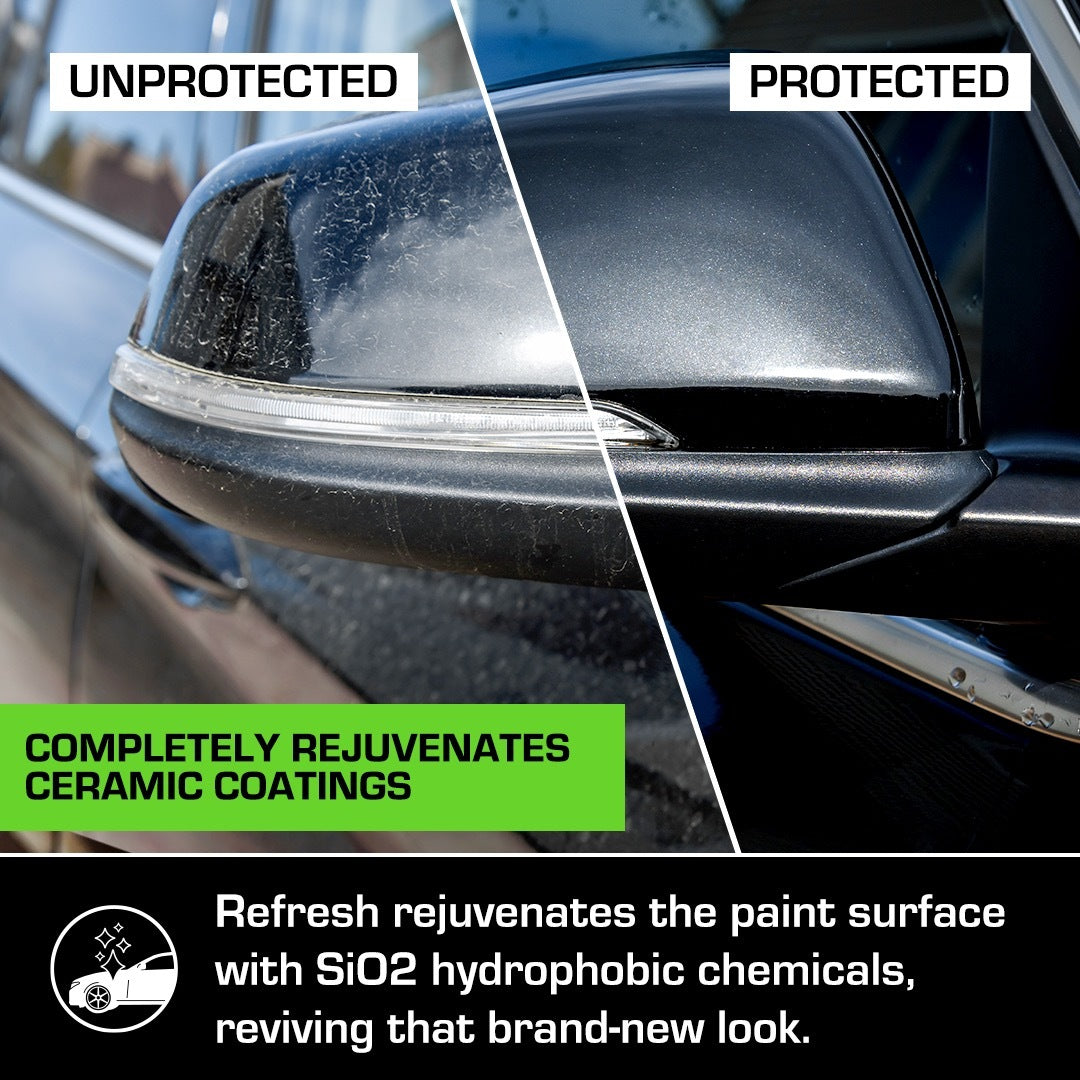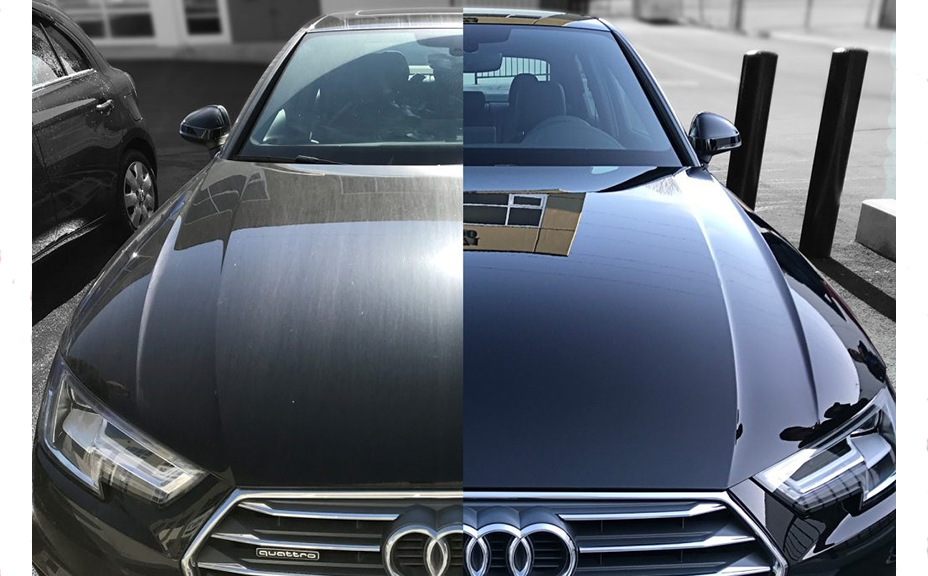Preserve your car’s paint with Ceramic Coating Newark — here’s how
Wiki Article
Discovering the Scientific Research Behind Car Ceramic Coating and Its Safety Characteristics
The scientific research of car ceramic coating presents a remarkable study in innovative auto security. Made up mainly of silicon dioxide and polymers, these coverings create a robust bond with lorry paint. This communication enhances resilience versus environmental risks while supplying hydrophobic advantages. The ins and outs of just how these coverings work and their long-term benefits continue to be much less understood. Ceramic Coating Newark. Unpacking these information exposes why ceramic coverings are coming to be a recommended selection for automobile careWhat Is Ceramic Coating?
Ceramic coating is a liquid polymer that chemically bonds to the surface of a car's paint. This advanced protective layer boosts sturdiness and supplies remarkable resistance to ecological factors. Unlike standard wax or sealants, which provide temporary defense, ceramic layers produce a durable shield that can stand up to severe conditions such as UV rays, acidic impurities, and severe climate. When applied correctly, the coating creates a hydrophobic surface area, causing water to grain and slide off, which assists in maintaining the lorry's sanitation. Additionally, it provides enhanced gloss and deepness to the paint, making the vehicle appear even more refined and lively. The application procedure normally entails extensive surface prep work, including cleaning and polishing, to ensure peak bonding. Consequently, ceramic coverings are becoming progressively popular among car enthusiasts and those looking for to safeguard their investments, promising to preserve the vehicle's visual allure while reducing the frequency of upkeep.The Structure of Ceramic Coatings
The elaborate formula of ceramic coatings mainly includes silicon dioxide (SiO2), which is stemmed from natural resources like quartz and sand. This vital part provides the structure for the coating's toughness and protective high qualities. Along with SiO2, ceramic coatings commonly include various polymers and additives that boost bond, versatility, and resistance to ecological elements. These compounds function synergistically to create a robust barrier against impurities such as dirt, chemicals, and UV rays.Furthermore, some formulations integrate titanium dioxide (TiO2) or various other nanomaterials, which can enhance the coating's hydrophobic properties, resulting in better water repellency. The precise structure can differ substantially amongst suppliers, impacting performance and long life. Eventually, the combination of these components culminates in a safety layer that not just enhances the aesthetic appeal of cars however also offers to lengthen their life expectancy by securing the surface area from potential damage.How Ceramic Coatings Job
Recognizing just how ceramic finishings work involves discovering their chemical make-up, which contributes to their protective top qualities. The application procedure is essential for attaining excellent outcomes, while longevity and longevity aspects figure out the coating's effectiveness over time. Together, these elements highlight the advantages and performance of ceramic finishings for lorry protection.Chemical Composition Explained
While several car owners seek long-lasting protection for their automobiles, the chemical composition of ceramic layers plays an essential role in their efficiency. These layers primarily include silicon dioxide (SiO2), which is originated from all-natural minerals. This substance creates a solid bond with the lorry's paint, developing a resilient, safety layer. Furthermore, numerous ceramic finishes contain titanium dioxide (TiO2), boosting their hydrophobic homes and resistance to UV rays. The visibility of polysiloxanes can even more boost adaptability and resilience. Together, these elements add to the coating's ability to push back water, dust, and contaminants, while also supplying a high-gloss surface. Understanding this chemical foundation helps car owners value the durable security used by ceramic coverings.Application Refine Overview
Using ceramic layers includes a precise process that ensures excellent bonding and protection for the car's surface area. At first, complete cleaning and decontamination of the car's exterior are performed to get rid of dust, gunk, and previous waxes. This action verifies that the surface is free from impurities that could prevent adhesion. Following this, the paint is often polished to improve clearness and eliminate any kind of imperfections. As soon as prepared, the ceramic coating is used in little areas using an applicator pad, permitting for uniform protection. The coating is after that left to heal, forming a solid chemical bond with the surface area. Correct healing times and problems are important, as they verify the coating attains its maximum effectiveness and safety top qualities.Longevity and Toughness Aspects
Ceramic finishes are developed to give long-lasting protection via their advanced chemical composition, which creates a robust barrier against ecological impurities. The resilience of these layers is affected by variables such as the thickness of the application, the high quality of the item, and the problems under which the car is exposed. High-grade ceramic coverings can last a number of years, resisting scrapes, UV rays, and chemical discolorations. Proper maintenance, including routine cleaning and periodic reapplication, can further improve long life. Additionally, environmental elements like environment and direct exposure to pollutants can affect the life expectancy of the coating. On the whole, when applied and preserved properly, ceramic coatings supply phenomenal toughness, making them a popular selection for car enthusiasts seeking to protect their car's appearance.Hydrophobic Residences and Water Repellency
Hydrophobic residential or commercial properties are a characteristic of quality car ceramic finishes, considerably enhancing the vehicle's surface efficiency. These layers develop a molecular bond with the car's paint, causing a surface that pushes back water effectively. When water enters call with a ceramic-coated surface, it beads up and rolls off, reducing the amount of fluid that remains on the paint. This habits not just contributes to a cosmetically pleasing appearance but additionally reduces the build-up of pollutants such as dust, gunk, and road salts.The enhanced water repellency causes simpler cleaning and maintenance, as less initiative is needed to eliminate unwanted substances. Additionally, the hydrophobic nature of ceramic finishings helps in avoiding water spots, which can mar the surface of uncoated surface areas. On the whole, the incorporation of hydrophobic buildings in ceramic coatings plays an essential role in maintaining the lorry's immaculate appearance while streamlining upkeep.Defense Versus Scratches and UV Damages
Car ceramic layers use substantial security against scrapes and UV damage. The scrape resistance mechanism develops a long lasting layer that soaks up effects, while the UV shielding benefits aid keep the car's paint honesty in time. With each other, these features add to a longer-lasting and aesthetically appealing coating.Scratch Resistance Mechanism
Utilizing advanced technology, ceramic coverings provide a durable guard versus scratches and UV damages, enhancing the durability and look of lorry surface areas. The scratch resistance device of these finishes is credited to their one-of-a-kind molecular framework, which creates a long lasting bond with the vehicle's paint. This bond creates a hard, protective layer that can take in effects and withstand abrasions. In addition, the smooth surface of the coating decreases friction, making it hard for impurities to stick and cause scratches. The chemical structure of ceramic finishings typically includes nanoparticles that strengthen the protective layer, more enhancing its strength. Subsequently, vehicles treated with ceramic finishings exhibit noticeably boosted scratch resistance compared to traditional wax or sealers, making sure a news pristine surface with time.UV Shielding Benefits
The protective top qualities of ceramic finishes extend beyond scrape resistance to include significant UV shielding benefits. These layers produce a durable barrier that reflects damaging ultraviolet rays, guarding the automobile's paint and underlying products. Prolonged exposure to UV radiation can lead to fading, oxidation, and wear and tear of the paint coating. By integrating ceramic coverings, lorry owners can effectively alleviate these threats, protecting the aesthetic charm and honesty of their cars. Additionally, the UV blocking buildings add to boosted durability, decreasing the regularity of repainting and maintenance. Inevitably, the assimilation of ceramic coatings provides a thorough service for protecting lorries from the damaging impacts of sun direct exposure, making certain a sustained, lively appearance over time.The Durability and Maintenance of Ceramic Coatings

Regularly Asked Concerns
Can Ceramic Coating Be Applied to Any Type Of Sort Of Car?
Ceramic coating can be used to numerous types of cars, consisting of vehicles, vehicles, and motorbikes. Nonetheless, surface prep work and compatibility with particular products are necessary for ideal bond and effectiveness of the coating.Exactly How Much Does Ceramic Coating Generally Cost?
Ceramic coating normally sets you back in between $500 and $2,000, depending on variables such as lorry size, coating top quality, and specialist application. The investment can offer lasting security and boost the automobile's look with time.
Is Expert Application Needed for Ideal Outcomes?
The need of professional application commonly relies on wanted outcomes. Specialists commonly assure correct surface preparation and application methods, leading to optimal bonding and durability of the coating, which may be challenging for unskilled people to accomplish.Can Ceramic Coatings Be Gotten Rid Of or Fixed?
Ceramic finishes can be gotten rid of or fixed, though the procedure might need certain solvents or techniques - Ceramic Coating Newark. Proper removal is vital to stay clear of damages to the underlying surface, Get the facts stressing the importance of expert aid for suitable resultsHow Does Porcelain Coating Contrast to Conventional Wax?
The contrast in between ceramic coating and typical wax discloses that ceramic layers use premium toughness, improved defense versus ecological pollutants, and longer-lasting luster, while wax requires more constant application and provides much less general resistance to damage.Report this wiki page